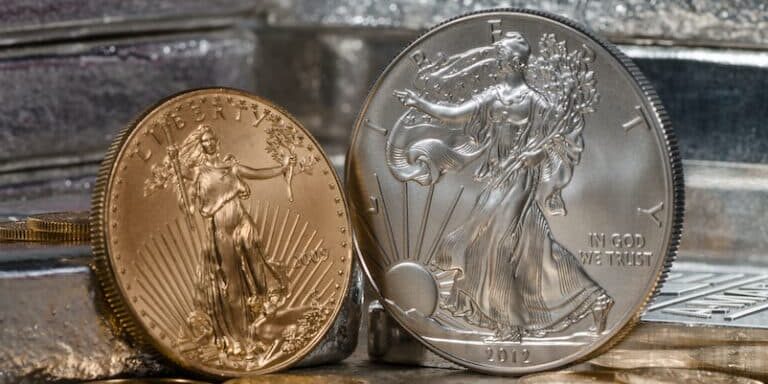
The Evolution Of Lady Liberty On Gold And Silver Coins
Images of the female form began appearing on coinage millennia ago and this tradition continues to be exceedingly important in Numismatics today. Ancient Greek coins featured the image of the Goddess of Wisdom, Athena, as well as other historical women and Goddesses. Roman coins also featured female deities like Libertas, the Goddess of Freedom, and the profiles of powerful women, such as the mothers of Caesars and behind the scenes power brokers.
Fast forward a few thousand years and today, the female form continues to be a driving force in Numismatics, often symbolizing the very ideals and spirits of issuing Nations. While the allegorical character of “Lady Liberty” is a prevalent emblem of the founding ideals of the United States, many countries also prominently feature metaphorical female figures on their currency.
Where Did This Tradition Begin?
This concept of Liberty has roots in the ancient Greek and Roman tradition where a multitude of gods and goddesses were worshipped as they were considered the sovereigns of certain values and aspects of life. Eleutheria was both the Greek word for and the female deity who represented Liberty or Freedom. This concept was also closely associated with the Goddess Artemis whose image was used on ancient Greek coinage.
Eventually, the Romans updated and renamed the Goddess, “Libertas.” In their society, she represented the republican ideal of personal liberty and freedom, which have always been represented by a female image in the classical tradition. It is no surprise that these early societies who established the first democracy and one of the most prominent republics in history respectively would so idolize the concepts of Liberty and Freedom. These idealized values and their common feminine representations were adopted by the Romantic and Naturalism movements and are thus represented in 19th Century depictions of these allegorical ideals.
Coins As Political Signifiers
In monarchy’s of old, a currency often carried the image of a governing individual which reinforced their power over the people they oversaw - after all one is likely going to give credit to the king or personage on the coin when one buys his meal. It was because of this close association with the monarchy that the Founding Fathers of the U.S. decided to break with this monetary tradition.
When the need for a uniquely American currency was introduced to Congress, President George Washington was first proposed to appear on the coinage. It was eventually decided and declared in the Mint Authorization Act of 1792 that instead of iconizing a single ruler that “upon each side of said coins there shall be an impression emblematic of Liberty, with an inscription of the world Liberty…” This move further removed the new nation from the concepts of monarchy and the singular rule of one man. It also helped establish the American ideals of freedom and representation for all, as the guiding principles for the new nation.
Lady Liberty represents the concepts of individuality, beauty, and self-reliance. This ideal is in the grasp of the common person, rather than being “to the manor born.” Both the American and French Revolutions were reactions to a political climate designed to empower the elite. These dynamic uprisings would ultimately champion individual representation to empower the majority of people rather than a ruling class of a specific monarch. This distancing from a historic person or class was supported by the use of representations of an allegorical ideal like Lady Liberty, the closely associated goddess Columbia and the French Marianne on coinage.
However, some ruling figures still appear on coins today, and they are not limited to Kings and Emperors. Like countless male figureheads before and after, Catherine the Great appears on Russian coinage as a way to solidify her power and image. More recently Queen Victoria and her great-great-granddaughter Elizabeth II on British coinage serve the same purpose: to celebrate and embody power and confer that power on the pictured person; a different approach to representational currency for sure.
Prevalence Of Liberty On U.S. Coinage
Although Congress used imprecise language in calling for an “impression emblematic of Liberty” on the obverse of all new federal coinage produced under the Mint Authorization Act of 1792, representing Liberty. The United States struck its first coinage featuring Liberty as wearing or almost wearing - her Roman “Freedom” or Phrygian Cap. The Phrygian cap was a symbol from antiquity that a person was not a slave. Variations on this image were struck well into the 20th Century for the U.S. circulating coinage although this ended with the 1947 Walking Liberty Half. It was from this iconic reverse design that one of the United States Mint’s most popular modern issues, the American Eagle Series originates from. This famous Adolph Weinman portrayal shows Liberty confidently moving towards the future, holding an oak branch along with a laurel, both military and civil symbols respectively.
The depiction of Liberty has changed a great deal over the years, some mere aesthetic changes, some symbolic. Certain designs feature Liberty in a seated position, others standing. She is more often than not pictured wearing a Freedom Cap or coronet that is engraved with the name Liberty. Sometimes her full portrait is depicted, as in the Standing Liberty Quarter, where she holds an olive branch as well as a shield, representing both peace and a readiness to defend herself. In others, only her head is depicted, as is the case of the Peace Dollar.
On the beloved Morgan Silver Dollar, she wears both the Phrygian Cap and an inscribed crown. Portrayals of Liberty continued on non-circulating coinage and persist today. Some of the more notable modern variations of Liberty are in the high relief American Liberty series which depicts “the different faces of Liberty” to more accurately reflect a culturally and ethnically diverse 21st Century America.
The Coinage Act of 1792 which created the U.S. Mint declared that one side of American coins had to show an “impression emblematic of Liberty,” a mythical female figure who had appeared as a symbol of America in colonial cartoons and prints, according to the Federal Reserve Bank of Boston. The first U.S. coin bearing an image of Lady Liberty was stuck in 1793. Lady Liberty was chosen for the Chain Cent because she perfectly represented America’s promise of freedom. Henry Voigt, the chief coiner at the Mint, designed Lady Liberty with long, flowing hair. Critics complained that she appeared unattractive and disheveled.
Flowing Hair Dollar
Robert Scot, the Mint’s first engraver, tamed Lady Liberty’s mane with his Flowing Hair dollar in 1794. The 1794 version of this silver coin is hard to come by with only 150 to 200 of them remaining. More of the 1795 coins exist but they’re also highly coveted nonetheless.
Draped Bust Dollar
Her hair pulled back and styled with a bow, Lady Liberty went on to grace the front of the 1795 Draped Bust dollar. As the coin’s name suggests the front shows a bust of Lady Liberty designed by artist Gilbert Stuart. She’s surrounded by 13, 15, or 16 stars, depending on how many American colonies there were when each coin was minted. This depiction of Lady Liberty remained on silver dollars through 1804.
Liberty Seated Dollar/Gobrecht Dollar
Decades after her debut, Lady Liberty got to take a rest in 1836 with the introduction of the Liberty Seated dollar, also known as the Gobrecht dollar. Christian Gobrecht, an engraver at the Mint gained credit for designing this coin which went into wide circulation in 1840. Some form of the Liberty Seated dollar continued to be produced through 1873.
Trade Dollar
The Trade dollar emerged in 1873 as a rival to the Mexican peso. At the time, Chinese businesses favored the peso over the U.S. dollar because the Mexican coin contained more silver. The U.S. coin features Lady Liberty sitting on a bale of goods and holding a branch in her right hand and a “LIBERTY” inscribed ribbon in her left hand. The U.S. halted the production of the Trade dollar in 1887.
Morgan Dollar
Under a federal law passed in 1878, mass production of silver dollars returned. With this came yet another look for Lady Liberty. George T. Morgan’s design depicts Lady Liberty in profile. The most significant change was that Lady Liberty was an American woman instead of a Greek figure. She was modeled after a real woman Anna Willess Williams who was later nicknamed the “Silver Dollar Girl.” The Morgan dollar reigns as one of the most popular of all American coins, thanks to its large size, ample supply, and pleasing appearance according to the Professional Coin Grading Service (PCGS).
Peace Dollar
On the Peace dollar which premiered in 1921, Lady Liberty faces left and wears a crown of spies (similar to those seen on the Statue of Liberty which was unveiled in 1886). The word “LIBERTY” is above her head and the words “IN GOD WE TRUST” are below. Designed by Italian-American sculptor Anthony de Francisci the coin celebrates the end of World War I. The artist’s wife Teresa de Francisci served as the model. These silver dollars were minted from 1921 through 1928 and again in 1934 and 1935.
Walking Liberty Half Dollar
Lady Liberty shines on this silver coin which was minted from 1916 to 1947. The Walking Liberty half dollar has been praised as one of the most stunning depictions of Lady Liberty to ever appear on a coin. The work of German-born American sculptor Adolph Weinman, this coin design shows Lady Liberty walking towards the sun and the dawn of a new day. She is carrying laurel and oak branches to symbolize military and civil victory and her outstretched represent her attempts to impart the spirit of liberty to others.
Silver American Eagle Coin
This silver coin, first minted in 1986, takes its name from the spectacular American eagle on the reverse side, designed by John Mercanti, who retired in 2010 as the Mint’s chief engraver. The front of Silver American Eagle Coin is equally spectacular featuring Weinman’s iconic Walking Liberty image.
Gold American Eagle Coin
The Gold American Eagle Coin which also premiered in 1986 rivals the Silver American Eagle coin for sheer beauty. This coin, one of the most popular bullion coins in the world, showcases a gorgeous image of Lady Liberty created in the early 1900s by legendary sculptor Augustus Saint-Gaudens. The design was initially made of the $20 Saint-Gaudens Double Eagle Gold Coin. A full-length figure of Lady Liberty dominates the front of the Gold American Eagle Coin. Her hair is windswept and her gaze is intense. She holds a torch in her right hand and an olive branch in her left hand. It appears as if she’s striding right off the coin. A family of bald eagles populates the reverse side of the coin.
American Liberty High Relief Gold Coin
A more contemporary and lifelike Lady Liberty appears on the 2015 American Liberty High Relief Gold Coin. The front of the coin which has a mintage of 50,000 and a nominal denomination of $100 features Lady Liberty grasping an American flag in her left hand and bearing a lit torch in her right hand. A bald eagle in flight highlights the back of the coin.
Lady Liberty’s look for this coin was heavily influenced by the Citizens Coinage Advisory Committee, an 11 member panel that advises the U.S. Treasury security on themes for all U.S. coins and medals. The U.S. Commission of Fine Arts, a seven-member panel established by Congress in 1910, also weighed in on this design. For this coin, Lady Liberty’s creators were the sculptor Phebe Hemphill and designer Justin Kunz.
American Liberty 225th Anniversary Gold Coin
The American Liberty 225th Anniversary Gold Coin puts a modern twist on a classic design. In honor of its 225th anniversary, the U.S. Mint introduced in 2017 a coin offering a depiction of Lady Liberty as a black woman. The first time for a woman of color to appear on a Liberty coin. The $100 coin, designed by Justin Kunz and engraved by Phebe Hemphill shows a profile of Lady Liberty wearing a crown of stars with the inscriptions “LIBERTY,” “1792,” “2017,” and “IN GOD WE TRUST.” The back of the coin features an eagle in flight. The Mint is producing just 100,000 of these special gold coins.
Other Important Allegorical Woman On Coinage
Liberty is not only an American concept. The young country adopted such ideals from Ancient and contemporary nations as was detailed above. An allegorical representation appears on French coinage in the form of Marianne, an often bare-breasted woman wearing a Phrygian Cap. What Lady Liberty is the U.S., Marianne is to France. She is the representation of France as a nation and the ideals it promotes such as liberty and reason. She became a popular representation during the French Revolution which so influenced the establishment of the United States.
Helvetia, known as the “goddess protector” frequently appears on Swiss coinage as she represents the country and its ideals, namely unity. She is often portrayed with braided hair topped with a wreath which symbolizes the unification of the various cantons of Switzerland which occurred in 1848. She is sometimes grasping a spear and always carrying a shield that bears the Swiss Arms. Her depiction and thus that of Switzerland shows both her defensiveness and her ability to protect herself as well as the importance of unity in the country’s history.
Similar allegories like Ceres, the Goddess of the Harvest, who appears on French coins, and Britannia, the Goddess of the Sea and patron protector of Great Britain who to this day still appears on British coinage also celebrated related concepts such as protection, renewal, beauty and the like. The French Marianne with her Freedom Cap and these related allegories were and are, all depictions of the same concept: purity and naturalism, beauty, power, resilience, agency, and an ideal state of being, namely “free”.
The Continuing Presence And Contributions Of Women To Numismatics
The allegorical representations of women on coinage has its roots in antiquity and remains an important tradition to this day. The U.S. Mint is currently striking their High Relief Liberty series in gold and silver. These depictions of Liberty as Caucasian and African American women, and future plans for Asian and Hispanic depictions of Liberty, underscore how our conception of Liberty is changing and becoming more representative of the society in which we live. In 2017, the U.S. Mint released the first-ever African American depiction of Lady Liberty to mark the 225th anniversary of the founding of the United States. In the words of the U.S. Mint itself on the release: “Our newest Lady Liberty is a modern rendition of this iconic figure that embodies ideals of freedom and equality first outlined in our Declaration of Independence.”
In 2015, the U.S. Treasury Department announced plans to include portraits of notable women on circulation paper currency beginning in 2020. The last time a woman was featured on U.S. circulating paper currency was in 1886 when the portrait of Martha Washington, the First Lady of the United States was used on a $1 Silver Certificate.
Both historical and modern women have made great contributions to the field of Numismatics and U.S. coins over the years. For instance, Laura Gardin Fraser, co-designer of the 1926 Oregon Trail Half Dollar and the 1999 George Washington $5 gold coin, is the only designer to contribute to both the Modern Commemorative series and Class Commemorative series.
Elizabeth Jones, the 11th Chief Engraver of the United States Mint was the first, and to this day, the only, woman to occupy the storied post. Contemporary designers and sculptors Phebe Hemphill, Donna Weaver, Renata Gordon, Barbara Fox, Emily Damstra, and Patricia Lucas-Morris have contributed some of the most meaningful and attractive designs in the U.S. Mint’s Modern Commemorative program in recent years.
Not only is our conception of Liberty evolving as our society and culture evolve, but Numismatics is also changing too. Now we have women creating new and exciting designs of Liberty and coinage in general, in a field that has historically been dominated by men. We have women becoming involved as collectors, dealers, and numismatic writers at an unprecedented level. These are exciting developments for the field and suggest new, diverse, and interesting points of view, and thus ways of collecting to come in the future.
The financial market is crumbling and EVERYONE will be affected. Only those who know what's going on and PREPARE will survive... dare we say thrive. Our 7 Simple Action Items to Protect Your Bank Account will give you the tools you need to make informed decisions to protect yourself and the ones you love.












